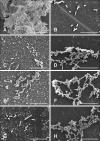Combination of berberine and ciprofloxacin reduces multi-resistant Salmonella strain biofilm formation by depressing mRNA expressions of luxS, rpoE, and ompR
- PMID: 30304890
- PMCID: PMC6265579
- DOI: 10.4142/jvs.2018.19.6.808
Combination of berberine and ciprofloxacin reduces multi-resistant Salmonella strain biofilm formation by depressing mRNA expressions of luxS, rpoE, and ompR
Abstract
Bacterial biofilms have been demonstrated to be closely related to clinical infections and contribute to drug resistance. Berberine, which is the main component of Coptis chinensis, has been reported to have efficient antibacterial activity. This study aimed to investigate the potential effect of a combination of berberine with ciprofloxacin (CIP) to inhibit Salmonella biofilm formation and its effect on expressions of related genes (rpoE, luxS, and ompR). The fractional inhibitory concentration (FIC) index of the combination of berberine with CIP is 0.75 showing a synergistic antibacterial effect. The biofilm's adhesion rate and growth curve showed that the multi-resistant Salmonella strain had the potential to form a biofilm relative to that of strain CVCC528, and the antibiofilm effects were in a dose-dependent manner. Biofilm microstructures were rarely observed at 1/2 × MIC/FIC concentrations (MIC, minimal inhibition concentration), and the combination had a stronger antibiofilm effect than each of the antimicrobial agents used alone at 1/4 × FIC concentration. LuxS, rpoE, and ompR mRNA expressions were significantly repressed (p < 0.01) at 1/2 × MIC/FIC concentrations, and the berberine and CIP combination repressed mRNA expressions more strongly at the 1/4 × FIC concentration. The results indicate that the combination of berberine and CIP has a synergistic effect and is effective in inhibiting Salmonella biofilm formation via repression of luxS, rpoE, and ompR mRNA expressions.
Keywords: Salmonella; berberine; biofilm; drug combinations; multidrug resistance.
Conflict of interest statement
Figures




Similar articles
-
Effect of the luxS gene on biofilm formation and antibiotic resistance by Salmonella serovar Dublin.Food Res Int. 2018 May;107:385-393. doi: 10.1016/j.foodres.2018.02.039. Epub 2018 Feb 17. Food Res Int. 2018. PMID: 29580499
-
In vitro characterization and inhibition of the interaction between ciprofloxacin and berberine against multidrug-resistant Klebsiella pneumoniae.J Antibiot (Tokyo). 2016 Oct;69(10):741-746. doi: 10.1038/ja.2016.15. Epub 2016 Mar 2. J Antibiot (Tokyo). 2016. PMID: 26932407 Free PMC article.
-
Opposite effects of cefoperazone and ceftazidime on S‑ribosylhomocysteine lyase/autoinducer-2 quorum sensing and biofilm formation by an Escherichia coli clinical isolate.Mol Med Rep. 2014 Nov;10(5):2334-40. doi: 10.3892/mmr.2014.2540. Epub 2014 Sep 5. Mol Med Rep. 2014. PMID: 25189202 Free PMC article.
-
Azithromycin and ciprofloxacin: a possible synergistic combination against Pseudomonas aeruginosa biofilm-associated urinary tract infections.Int J Antimicrob Agents. 2015 Apr;45(4):359-67. doi: 10.1016/j.ijantimicag.2014.11.008. Epub 2014 Dec 16. Int J Antimicrob Agents. 2015. PMID: 25604277
-
AI-2/LuxS is involved in increased biofilm formation by Streptococcus intermedius in the presence of antibiotics.Antimicrob Agents Chemother. 2009 Oct;53(10):4258-63. doi: 10.1128/AAC.00546-09. Epub 2009 Jul 13. Antimicrob Agents Chemother. 2009. PMID: 19596873 Free PMC article.
Cited by
-
Therapeutic effects and mechanisms of berberine on enteritis caused by Salmonella in poultry.Front Microbiol. 2024 Nov 27;15:1458579. doi: 10.3389/fmicb.2024.1458579. eCollection 2024. Front Microbiol. 2024. PMID: 39664055 Free PMC article.
-
An alternative approach to combat multidrug-resistant bacteria: new insights into traditional Chinese medicine monomers combined with antibiotics.Adv Biotechnol (Singap). 2025 Feb 7;3(1):6. doi: 10.1007/s44307-025-00059-7. Adv Biotechnol (Singap). 2025. PMID: 39918653 Free PMC article. Review.
-
Effects of Traditional Chinese Medicine and its Active Ingredients on Drug-Resistant Bacteria.Front Pharmacol. 2022 Jun 2;13:837907. doi: 10.3389/fphar.2022.837907. eCollection 2022. Front Pharmacol. 2022. PMID: 35721131 Free PMC article. Review.
-
The effect of berberine chloride and/or its combination with vancomycin on the growth, biofilm formation, and motility of Clostridioides difficile.Eur J Clin Microbiol Infect Dis. 2020 Jul;39(7):1391-1399. doi: 10.1007/s10096-020-03857-0. Epub 2020 Mar 5. Eur J Clin Microbiol Infect Dis. 2020. PMID: 32140903 Free PMC article.
-
Targeting effect of berberine on type I fimbriae of Salmonella Typhimurium and its effective inhibition of biofilm.Appl Microbiol Biotechnol. 2021 Feb;105(4):1563-1573. doi: 10.1007/s00253-021-11116-1. Epub 2021 Jan 26. Appl Microbiol Biotechnol. 2021. PMID: 33496815
References
-
- Abdallah M, Benoliel C, Drider D, Dhulster P, Chihib NE. Biofilm formation and persistence on abiotic surfaces in the context of food and medical environments. Arch Microbiol. 2014;196:453–472. - PubMed
-
- Bai L, Zhao J, Gan X, Wang J, Zhang X, Cui S, Xia S, Hu Y, Yan S, Wang J, Li F, Fanning S, Xu J. Emergence and diversity of Salmonella enterica serovar Indiana isolates with concurrent resistance to ciprofloxacin and cefotaxime from patients and food-producing animals in China. Antimicrob Agents Chemother. 2016;60:3365–3371. - PMC - PubMed
-
- Castelijn GA, Parabirsing JA, Zwietering MH, Moezelaar R, Abee T. Surface behaviour of S. Typhimurium, S. Derby, S. Brandenburg and S. Infantis. Vet Microbiol. 2013;161:305–314. - PubMed
-
- Castelijn GA, van der Veen S, Zwietering MH, Moezelaar R, Abee T. Diversity in biofilm formation and production of curli fimbriae and cellulose of Salmonella Typhimurium strains of different origin in high and low nutrient medium. Biofouling. 2012;28:51–63. - PubMed
MeSH terms
Substances
LinkOut - more resources
Full Text Sources
Medical

